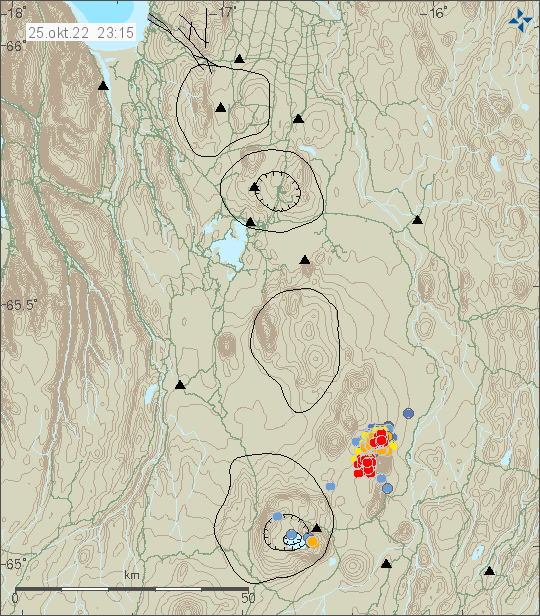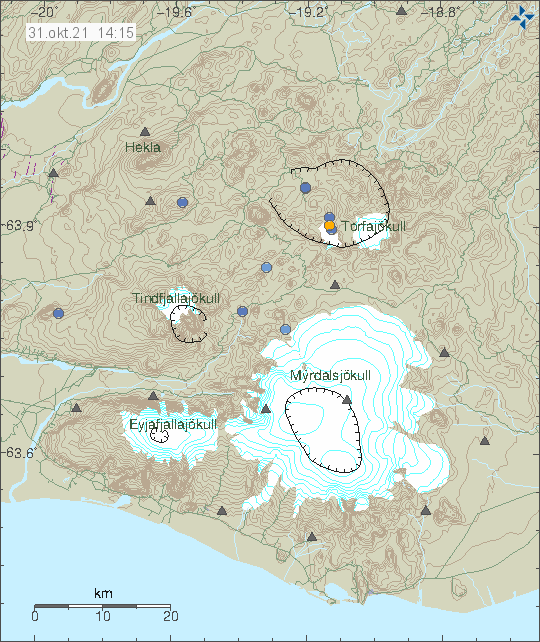Early morning of 7. January 2023 an earthquake swarm took place in Brennisteinsfjöll volcano. All of the earthquakes are small in magnitude and largest earthquake had a automatic magnitude of Mw1,0. Depth of this earthquakes is from 7 km and down to 9,5 km depth.
Continue reading “Earthquake swarm in Brennisteinsfjöll volcano”
Ongoing earthquake swarm in Reykjanes volcano (close to Reykjanestá)
Today (6. January 2023) an earthquake swarm started in Reykjanes volcano close to Reykjanestá area. Largest earthquake had a magnitude of Mw3,0 at 00:31 UTC. Other earthquake have been smaller in magnitude.
Continue reading “Ongoing earthquake swarm in Reykjanes volcano (close to Reykjanestá)”
Earthquake swarm in Fagradalsfjall volcano
Today (27. December 2022) an earthquake swarm took place in Fagradalsfjall volcano. This earthquake swarm was small in magnitude, as most earthquake swarms are in Fagardalsfjall volcano.
Continue reading “Earthquake swarm in Fagradalsfjall volcano”
Earthquake swarm in Reykjanes volcano
Yesterday (26. December 2022) an earthquake swarm took place in Reykjanes volcano. Just on the Reykjanestá area. This earthquake swarm was mostly in the ocean and on the Reykjanes ridge but some earthquakes where on the Reykjanes peninsula on land.
Continue reading “Earthquake swarm in Reykjanes volcano”
Possible dyke intrusion in Fagradalsfjall volcano
Early morning today (10-November-2022) an swarm of earthquakes took place slightly north of the place where the eruption in August 2022 took place in Fagradalsfjall volcano. This possible dyke intrusion was small and only lasted for about 1 hour before it stopped. Depth of the earthquakes was from 5 km to 7 km.

This activity might give a clue on in what area next eruption is going to take place in Fagradalsfjall mountain. Based on earlier eruption there won’t be any warning before an eruption earthquake swarm starts. In August that eruption started with a minor earthquake swarm, created from a dyke intrusion that was happening. In the hours before an eruption starts there’s going to be a strong earthquake swarm, based on what happened just before the eruption in August. It is interesting if the eruption activity moves north-east, rather than south-west. Why that happens, if it does so, is not something I am clear on why happens.
Change in the earthquake activity in close to Herðubreið mountain
Sometime yesterday (24-October-2022) a change happened in the earthquake swarm close to Herðubreið mountain. I am not sure when that change happened and it probably took few hours to happen before I detected it. But the change seems to be that now the earthquake swarm is at two locations and not just one. The second change is that the earthquake swarm is now getting more intense. The earthquakes at the writing of this article are minor, only magnitude Mw0,0 to Mw2,7 at the strongest. Nothing above Mw3,0 so far, but that might change without warning. Depth of this earthquake swarm is around 2 to 3 km at the writing of this article.

What is going to happen next is impossible to know. An eruption in this area has not happened for at least 12.000 years or even longer. I don’t know if stronger earthquake activity is required for this area for an eruption to happen. It already is rather fractured from older earthquake activity and rift activity, that makes it possible for magma to have easier paths to the surface without much earthquake activity. That is at least one idea on the situation in this area. I might be wrong on this, since I don’t have information on the finer details of the crust around Herðubreið mountain.
Deep inflation detected in Fagradalsfjall mountain
According to a news report today (16-November-2021) inflation has been detected deep under Fagradalsfjall mountain, that is part of Krýsuvík-Trölladyngja volcano system. This inflation suggests that an eruption might start again in Fagradalsfjall mountain, it remains impossible to know when such an eruption might start. Since there is a lot that suggest this inflation is because of magma collecting at depth under Fagradalsfjall mountain. When or if that results in a eruption in the future is impossible to know.
This inflation is now large enough to be seen on satellite images that monitors deformation in the upper crust. In the upper crust this deformation appears small, but that is not all the story in this.
Icelandic News (in Icelandic)
Gosið enn í dvala – Mæla litlar hreyfingar á miklu dýpi (Rúv.is)
Donations
Please remember to support me. In November I am really broke in November because of computer repairs. Thanks for the support. 🙂
Two strong earthquakes in Bárðarbunga volcano
Today (12-November-2021) at 15:16 and 15:35 two earthquakes with magnitudes of Mw3,3 and Mw3,6 took place in Bárðarbunga volcano.
Continue reading “Two strong earthquakes in Bárðarbunga volcano”
Long period, low frequency earthquake activity increases in Torfajökull volcano this morning
Around 10:00 UTC this morning (31-October-2021) the earthquake activity of long period and low frequency earthquakes increased this morning in Torfajökull volcano. The current swarm now seems to be coming from the glacier part of the caldera, the earlier activity seems to have taken part some place in north part of the Torfajökull volcano caldera. Location of the this earthquake activity is difficult if not impossible because of the type of earthquake activity being generated in Torfajökull volcano.

The situation is difficult to figure out just by looking at seismometer data. Icelandic Met Office is going to make a flyover today with the help of Icelandic Coast guard and try and see what is going on in Torfajökull volcano. Last eruption in Torfajökull volcano was in the year 1477 and I don’t have any idea what happens before an eruption in this volcano.
Inflation and earthquake activity in Askja volcano
Inflation has been increasing in Askja volcano over the last few weeks. According to latest news that inflation is now at 14 cm, since the inflation was detected at the end of August. On Saturday 9-October-2021 an earthquake with magnitude of Mw3,2 was detected in Askja volcano (I’ll try and add the picture later if I remember). This is was the strongest earthquake in Askja volcano in the last 20 years according to the news.
Askja is remote and there are no or limited amounts of web cameras in the area. With winter arriving going there is impossible for most people. If an eruption happens this winter the best view is probably going to be harmonic tremor data until pictures appears from Icelandic Met Office or someone with an air plane (if the weather allows for that).
